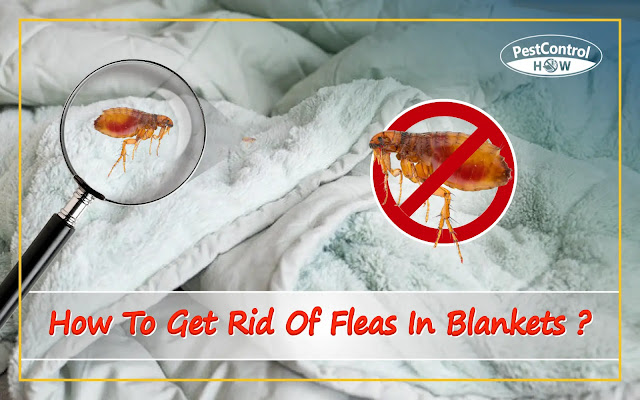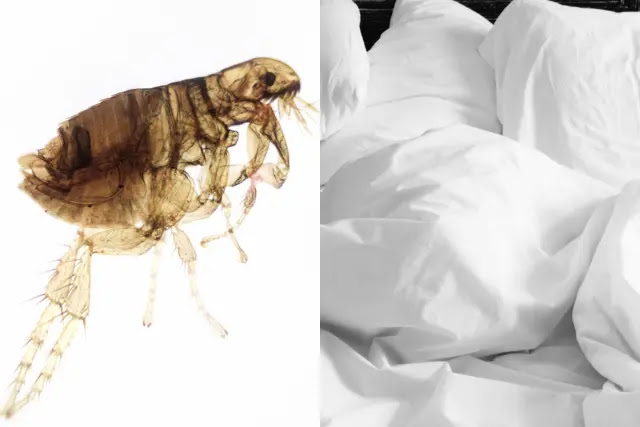Although fleas mainly feed on non-human animals, their chances of biting and infecting humans are very high! Unfortunately, these persistent pests can be extremely difficult to get rid of!
Fleas can survive for 100 days or more without a host! Even worse, the most commonly used flea treatments just kill adult fleas. This means that fleas may continue to emerge in your home months after you thought an infestation has been exterminated completely.
These feared critters can invade homes in many ways. For instance, you may have walked by an area where Charlie, your neighbor's dog, just dropped off a flea. This flea will jump onto you, and somehow, it will end up in your house!
But the most common way for fleas to invade your house is when your pet (cat or dog) attracts the vile creatures and brings them into your home. Fleas can also be introduced into the house via old furniture, clothes, and other infested items.
Once they invade, these bloodsuckers will quickly spread to other areas of your house. They especially prefer cushions, mattresses, carpeting, and bedding. Fleas require blood to survive and lay eggs. And it's possible that they can infest your blankets in search of a host to feed on. But they will only feed on human blood when no animal hosts are available.
Given that fleas can carry and transmit diseases to their hosts, including humans, learning how to get rid of fleas in blankets is important.
Can Fleas Live In Your Bed
It's possible but rare.
A flea is a small wingless insect that is sustained in the blood of mammals and birds. As mentioned above, these jumping insects can infest multiple areas of your house. However, they are likely to infest beds and furniture where pests sleep more than a homeowner's bed.
Fleas enjoy a warm environment. And should they gain access to your bed, the adult fleas will lay their eggs within your mattress. They will then produce fecal matter (pre-digested blood) to feed their larvae.
Young fleas also feed on the blood of a host by biting and sucking blood. Therefore, finding out where these parasites are hiding is the most important step toward learning how to get rid of fleas in blankets.
How Do Fleas Get In Bed
Generally, fleas do not infest the bed or beddings of a homeowner. However, fleas are opportunistic parasites! And it is possible that you have observed fleas in your bed, mattress, or blankets!
If you allow your pets in your bedroom, or perhaps you let them sleep in the same bed as you, then fleas can dislodge from the pet and hide in your bed.
Additionally, if you don't wash and change your bedding regularly, the chances for fleas to take up residence in your bed are high.
If they deem your bed suitable, fleas will latch on for a long time. During this time, they will take a blood meal from the human host, mate, and lay eggs in the bedding. The eggs will hatch in as little as 1-10 days, depending on the temperature and humidity in your bedroom. The larvae will mature into adult fleas within the shortest time, lay their eggs, and perpetuate the cycle!
Even so, the most likely situation is that flea eggs, larvae, and pupae are living in your pet's bed and bedding or have taken residence under your bed.
How Long Can Fleas Live In Bed?
If an animal host is not available, fleas can survive solely on a diet of human blood! These tiny pests can live up to a year with enough blood supply. But without a blood meal or host, fleas can only survive for 1-2 weeks!
Generally, spring and summer are fleas' best seasons. The warm and humid conditions in your bedroom may allow the fleas to live much longer than they would under very cold or dry conditions.
These irritating pests like to burrow into bedding, but unless you're spending enough time in your bed to feed them, fleas won't live there for long!
Can Fleas Live In Humans?
When you discover fleas in your bedding, it's common to worry about whether or not fleas can live in humans. While these disgusting critters feed on human blood, they only do so when absolutely no animal hosts are available!
Once an adult female flea has had a blood meal, she can mate and start laying eggs. But because of their high body temperatures, fleas cannot stay on humans for long! And they also can't breed on humans! This means they will need to find an animal host; otherwise, they won't reproduce or increase their numbers.
According to a noble study on fleas, a female cat flea can only stay on humans for approximately 7.4 minutes, while a male cat flea can only stay for an average of 4.4 minutes.
The survival of fleas typically depends on animal hosts like your dog or cat. Fleas can survive for 100 days without a host. During this time, they cannot breed! Fleas cannot lay a single egg unless they have had a blood meal!
Without a host, their population will gradually dwindle, and they will die out! But as soon as they get a blood meal, the females will lay eggs in 1-2 days after feeding, and the infestation will survive.
I Woke Up With An Itchy Bite: Do I Have Fleas In Bed?
Homeowners often confuse flea bites with bed bug bites. That's understandable because the two insects leave behind small, red welts or dots on the bitten area. Even so, there are many ways to distinguish the two.
Consider the following differences:
Flea bites vs. Bed bug bites
- You will commonly find flea bites on the lower half of your body, like the waist and ankles, and in the warm, moist areas, for instance, the bends of your knees or elbows. Comparably, bed bug bites are often found on the upper half of the body, like in the exposed areas of your arms, neck, and face.
- A common symptom of flea bites is small red marks on the bitten area, accompanied by intense itching! Bed bug bites can be identified by a relatively small raised area of the skin, with a dark red spot in the middle. Bed bug bites are often itchy and feel a burning sensation a few days after the bite.
- Flea bites are often grouped in three small bumps, while bed bug welts appear in a zigzag pattern.
Signs Of Fleas In Bed
Your furry friends frequently scratching themselves is the earliest sign of a flea infestation in your home. Unless you take immediate action, fleas will soon become a big problem, given that they reproduce and spread rapidly. To learn how to get rid of fleas in blankets fast and effectively, knowing the early signs of fleas in your bed is important.
Bite: Perhaps you woke up with itchy small red marks along your waist, feet, or ankles? The high chances are that you have an active flea infestation. If the bites appear grouped together in three small bumps, it's time you learn how to get rid of fleas in bed!
Flea dirt: Flea dirt or flea poop appears like very tiny black dots. If you have fleas in your bed or blanket, you'll likely see flea poop on your light-colored sheets. Flea poop is typically made up of a host's blood and is usually excreted while the fleas are sucking blood!
Pet scratching: It can be pretty difficult to see flea bites on your furry friend. As such, you want to pay keen attention and notice if and when your pet is scratching. These notorious pests can infest your pet's entire body, causing serious itching and discomfort. Usually, your pet will appear to gnaw or bite on its skin.
Flea eggs: Adult female fleas can lay up to 8 eggs after each blood meal. Flea eggs are generally loose with an oval shape and a softshell with an off-white color. The eggs will remain in your blanket until they hatch, which can take up to 1-12 days.
How To Get Rid Of Fleas In Blankets
Learning how to get rid of fleas in a blanket and bed is rather straightforward. However, it is a multi-step process, and you'll have to be equipped with the right tools to exterminate the pests effectively and completely. When exterminating fleas in the house, keep in mind that the pests cannot survive extreme heat!
1. Wash All Bedding
Strip your bed completely and immediately machine wash all sheets, covers, pillowcases, blankets, and duvets in hot water. Put them in the dryer as soon as they've been washed and set the hottest temperatures.
2. Seal Nonwashable Bedding In A Plastic Garbage Bag
Any nonwashable bedding should be gathered into a plastic garbage bag. Immediately spray inside with an organic flea insecticide and close the bag tightly. Leave the bag closed for approximately 14 days to kill the fleas completely. Regularly shake the bag to force any remaining pupae from its cocoon. For the best results, occasionally open the bag slightly, respray the items and retie the bag. After the 14 days, remove the items, shake them out a good distance from the house, and then dry-clean them.
3. Use Organic Insecticides
Consider buying a highly effective and organic insecticide, for instance, those made from chrysanthemums. Shake the powder well and dust it over your mattress and bed. Ensure the treatment gets into all cracks and crevices along the bed. Leave the treatment to work for a few hours or the suggested time on the product labeling before vacuuming the mattress thoroughly.
4. Deep Clean Your Mattress
If there are fleas in your bedding, it's not unlikely that they have spread to your mattress and pillows. Give the mattress and pillows a more serious cleaning by vacuuming each corner. Ensure you also vacuum the blankets, furniture, nearby rugs, and carpets. You must dispose of the vacuum bags to prevent flea-reinfestations!
5. Get Fleas Off Your Pet
If your canine friend or cat is the cause of the flea infestation, then you'll need to clean it in lukewarm water and a mild soap (or recommended pet shampoo) to get fleas off its fur and skin. Wash your pet's bedding in hot water every few days.
Explore more:




